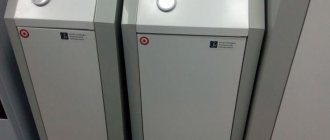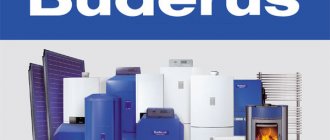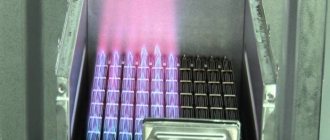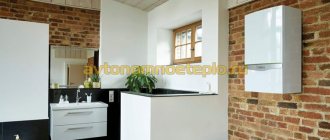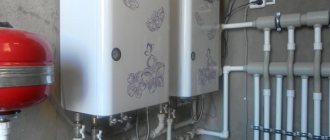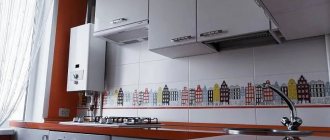You have built a residential building and want to move in as quickly as possible and finish the interior arrangement. The question arises: how to heat water and heat rooms if the home is not gasified? The simplest way to quickly organize heating and hot water supply is to install a double-circuit boiler that runs on liquefied gas (abbreviated as LPG).
The heating unit must be reconfigured to a propane-butane mixture, and after connecting the main line, the factory settings must be returned. We will reveal the features of installation, adjustment and operation of a heat source using bottled gas.
How does liquefied gas differ from natural gas?
As is known, the main gas composition is dominated by methane, whose lower calorific value is approximately 9 kW/m³. The substance is transported and burned exclusively in a gaseous state; the transition to the liquid phase occurs as a result of cooling to deep low temperatures.
LPG – liquefied hydrocarbon gases, used in boilers, water heaters and internal combustion engines of cars, are a homogeneous mixture of propane and butane. Let us list the properties of this fuel:
- calorific value - about 6.4 kW per 1 dm³ (liter);
- gas easily transforms into the liquid phase under pressure;
- LPG is transported and stored in the form of a liquid, pumped into standard cylinders or storage tanks;
- Before combustion, the fuel must evaporate; propane-butane is supplied to the boiler burner or internal combustion engine cylinders in a gaseous state;
- Over time, condensation accumulates at the bottom of the container, taking away the useful volume of the container.
Addition. A significant advantage of methane over LPG is its price - natural gas is significantly cheaper. Even the higher calorific value and lower propane consumption do not cover the difference in cost. A more detailed comparison of different types of fuel is presented in a separate review.
When refueling with liquefied fuel, the container is never filled to the top. 1/5 of the tank (20%) must remain empty - this volume is used to transfer the fuel into the gas phase. If the vessel is filled to capacity, the evaporation area and the amount of LPG ready for combustion will sharply decrease. A standard 50 liter cylinder can be filled with a maximum of 40 liters of propane.
Tips for choosing a gas heater
Despite the differences between main methane and liquefied hydrocarbons, the same equipment is used to effectively burn these substances. To switch from one fuel to another, the boiler installation is adjusted, described in the following sections of the publication.
Key moment. Any propane gas boiler successfully consumes natural gas and vice versa. It will not be possible to use both energy carriers at the same time or switch with one press of a button - the transition involves partial disassembly, replacement of the burner fuel nozzles and adjustment of the gas valve.
All heat generators that consume natural gas can operate on propane-butane.
Accordingly, you need to choose and buy a heat generator for heating a private home according to the standard algorithm:
- Determine the power of the boiler unit. The best way is to calculate the thermal load for heating and multiply the result by a safety factor of 1.2. When buying a double-circuit boiler for hot water supply, set aside one and a half reserves.
- Choose a floor or wall model of the heat source. For a closed-type pumping system, it is better to take a suspended unit; for gravity distribution, a non-volatile stationary boiler.
- The optimal solution in the absence of a chimney duct is to install a turbocharged version of the heater with a closed combustion chamber. The removal of combustion products is organized through a double-walled coaxial chimney laid horizontally through the nearest outer wall.
- If you have an outlet channel and a limited budget, feel free to take an atmospheric heater, it will cost less than a supercharged model.
- Among dual-circuit installations, it is better to choose an option with a separate plate heat exchanger operating on DHW. It is easier to maintain such a water heating device than to clean a heat generator with a combined counterflow heater.
Note. For country houses and small apartments (up to 100 m²), there is a budget option - the so-called parapet boiler with a power of up to 12 kW. The unit is placed near an external wall and does not require the installation of a chimney - a short coaxial pipe leads directly to the street. Moreover, the combustion chamber is open, there is no fan and no electronics.
A set of nozzles designed to supply LPG
Initially, any of the listed heaters is designed to work with natural gas - methane. Since the caloric content of LPG is higher, the fuel jets in the boiler need to be replaced (popularly called injectors). Hence the advice: when purchasing a unit, immediately request an additional set of jets with smaller diameter holes intended for liquefied gas.
Since we are considering the problem of switching to LPG and the further operation of such installations, the topic of choosing a heat generator is covered concisely. You will find more useful information on this issue in another publication - how to choose an economical boiler for an apartment or private house.
Reasons and principles of boiler conversion
From the first lines, we would like to warn you that work on re-equipping the boiler to switch to a different type of fuel must be carried out by the foreman of the organization with which an agreement has been concluded for the supply of gas and maintenance of equipment.
However, any owner should know the essence and stages of the process for basic control of the actions of invited performers. And doubts about their competence sometimes justifiably creep in. Therefore, it is better to monitor the implementation of the procedure, on which, by the way, the safety of the home and household depends.
Conversion of the boiler to operation from liquefied gas sources is required if the installation of a main system to the house is postponed for an indefinite period or is impossible for technical reasons.
The source of liquefied gas required for the operation of an autonomous heating system is either a group of cylinders or a gas holder.
Boilers with a power of up to 35 kW can operate from one cylinder, but it is better to connect to a group of 2-4 pieces. This way you will have to refuel much less often.
If a floor-standing boiler is installed for heating the house, and a boiler is included in the circuit for preparing hot water, then it is better to install a gas holder to supply the equipment with gas.
It also happens that a gas service representative cannot get to a remote location. In this situation, the home master, of course, will try to do everything with his own hands. But for the result of the efforts of a craftsman inexperienced in the gas sector, he himself will bear responsibility, and the manufacturer’s guarantees will be void.
When purchasing a gas boiler for domestic use, we receive a device configured to process main-line fuel. A centralized gas pipeline supplies us with a mixture of flammable gases, in which methane predominates. The main gas enters the devices with a natural density and pressure of 21 mbar.
Liquefied gas is an exaggerated name for a mixture of propane and butane, in which either the first or the second component can predominate. It can contain predominantly butane with a slight admixture of propane, or vice versa, propane predominates by 99%.
The density of the liquefied mixture increases 600 times. The pressure does not increase as much, but it is still higher than that of natural fuel, 30-31 mbar.
To produce liquefied gas, the pressure of propane and butane is increased approximately 600 times. This procedure makes it possible to reduce the volume of fuel and store it in a liquefied state before use.
The types of gases that boilers operate on are standardized. They are assigned codes that the manufacturer indicates in the technical documentation. Thus, the boiler’s consumption of main gas is marked with code G20. The ability to operate the boiler from a liquefied mixture with a predominance of butane is designated G30, and from a mixture with a predominance of propane - G31.
In order for blue fuel to fulfill its significant duties, gas enters the combustion chamber through nozzles. There, gas is mixed with air using a burner in proportions that are optimal for a particular type of fuel. This means that gas must be supplied to the burner in the volume necessary for normal combustion.
Normal mixture formation is possible if the diameter of the nozzles is suitable for its implementation. The size of the supply holes determines how much gas under a certain pressure will enter the combustion chamber with a specific volume of air. That is why nozzles with different cross-sections are installed for liquefied mixtures and for main gas.
To switch to the consumption of liquefied gas, you do not need to radically alter the equipment, much less buy a new unit. You just need to change either just the injectors or the manifold (ramp) with injectors
Note that the cross-section of the nozzles is determined not only by the type of gas, but also by the power of the boiler itself. For your information, to operate a 10 kW unit operating at maximum operating mode, main gas requires 1.2 m³/h, liquefied mixture of any type 0.86 kg/h.
The more powerful the equipment, the more fuel is required to operate it. The larger should be the size of the nozzles that pass blue fuel into the combustion chamber. Their cross-section is clearly calculated and strictly regulated by the manufacturer, who produces burners with nozzles of a given diameter for a series of boilers of a given power.
When gas enters from the nozzle, the gas is mixed with a portion of the air it requires for the normal combustion process. Both components must be supplied to the combustion chamber in strictly controlled proportions
So how can you switch to liquefied gas if you didn’t initially think of buying a boiler for liquefied gas? That's right, replace either the entire manifold with the entire set of injectors, or just the injectors, leaving the manifold in place. The second option is not possible in all boilers.
In addition to replacing devices, to supply liquefied gas, you will also need to reconfigure the burner of a gas boiler with an electronic control type. This is necessary for the complete delivery of air in the volume required for the uninterrupted combustion process. The new settings will also ensure that the gas supply is interrupted if a risky situation arises.
You will also need to install a reducer designed to regulate the pressure of gaseous fuel. One or a group of cylinders can be connected to the gas reducer. The gas valve may need to be replaced if necessary.
To connect the boiler to cylinders or a gas tank, you need to set the reducer to the operating value of the gas pressure. Sometimes it is also necessary to change the gas valve in the boiler if it is not suitable for supplying gas at the required pressure
In any situation, before ordering a contractor to convert a wall-mounted or floor-standing gas boiler to liquefied fuel, you should consult the gas service that oversees your equipment and the gas supply to your facility.
They will tell you which devices you should purchase for translation. They will calculate how much the modernization will cost you along with the specialist’s payment.
Subtleties of installation and arrangement of the boiler room
We would like to highlight an important point right away. Installation, connection and startup of the heating unit for LPG can be done independently, but taking into account the following nuances:
- If you expect to subsequently gasify the house and connect the boiler to the main line, the installation must be done in accordance with the requirements of the regulations, without violations. Otherwise, the provider organization will not issue permission to connect.
We install the water heating device in accordance with the requirements and recommendations of the manufacturer - Another situation: there are no plans to connect to the gas pipeline. Then you need to install an underground container for fuel on the site - a gas tank, cylinders - a temporary option. Here you cannot do without a project, hiring a specialized company and putting the facility into operation. This means that the gas boiler must be installed according to all the rules.
- You carry out work at your own peril and risk. Therefore, you bear full responsibility for the safety of your home and your loved ones. We advise you to involve an intelligent engineer - a gas supply specialist, at least as a consultant.
Reference. Without documents confirming the commissioning of the gas tank and thermal power equipment, it will not be possible to organize the filling of the LPG tank.
General requirements for premises and installation of gas-fired heaters are set out in a detailed manual on a separate resource page. Here we list the points related to the use of liquefied fuel:
- Propane + butane is a rather insidious gas; it is heavier than air and, in the event of a leak, accumulates in the lower zone of the room. The furnace ventilation will have to be adapted - place one exhaust grille at a height of 30 cm from the floor, the second - under the ceiling. Provide an inflow at the opposite end of the room.
- For the same reason, you should purchase and install a gas analyzer connected to a solenoid shut-off valve above the floor. The latter is mounted on a pipeline supplying fuel from cylinders or a gas tank.
- It is strictly not recommended to place propane tanks in the furnace room. The gas pipeline is led out through the wall, where there is a metal cabinet with cylinders connected to a common fuel rail.
- A gas holder cannot be dug closer than 10 m from a residential building.
- The minimum number of cylinders is 2, and preferably four. One vessel will not provide the required fuel consumption due to the small evaporation area. Liquid fuel does not have time to turn into gas, the pressure in the network decreases, the boiler turns off or the water does not heat up enough.
The gas analyzer detects a propane leak and sends a signal to the shut-off valve, which shuts off the fuel supply
Advice. For the winter, heat the tanks in an outdoor closet - install a fan heater or a special element that fits onto the cylinder. Due to the drop in temperature, the walls of the containers freeze, and the rate of evaporation of the combustible mixture decreases. The result is a lack of gas, weak heating of the coolant and cold in the house.
Since the propane pressure in closed vessels exceeds the supply rate to the burner, the pressure must be reduced. At the outlet of the ramp that combines the cylinders, a pressure gauge and a reducer with an adjustment range of 20...60 mbar are installed. Traditional “frogs”, designed to maintain a constant pressure of 30 mbar, are successfully combined with floor heaters equipped with Italian automatic equipment SIT 630 and 710.
The valve automatically or on command switches the gas supply from the right and left sides of the ramp
Conversion of a wall-mounted boiler to LPG
The procedure includes 2 operations - replacing injectors (nozzles) and adjusting the gas valve pressure in different combustion modes. To perform adjustment work you need to prepare:
- standard set of tools - screwdrivers, pliers, etc.;
- open-end wrenches and small hexagons;
- dial or electronic pressure gauge showing pressure in millibars;
- flexible connecting tube suitable for fittings on the boiler.
Advice. It is more convenient to select the diameter of the tube after removing the front panel of the heat generator. The size should be sufficient for the pipe to fit tightly onto the valve fittings from the outside.
The first stage is partial disassembly of the unit and dismantling of the gas burner device. The goal is to get to the inner panel of the manifold, where the standard jets are screwed in. The sequence of work depends on the boiler model and generally looks like this:
- Remove the front panel of the device. On heaters of the Viessmann, Baxi, Buderus and similar brands, there is a control board behind it, which must be folded forward.
- Disconnect the ignition electrodes and pilot burner (if equipped).
- Unscrew the screws holding the main burner. Remove the part and set it aside.
- On the rear wall of the unit there is a manifold with nozzles. Change the jets by unscrewing with a flat-head screwdriver. Put the burner and electrodes back.
Recommendation. Before disassembling and adjusting, be sure to read the boiler operating instructions! The document often describes the procedure for converting to liquefied gas and indicates the pressure limits that need to be set on the valve.
After replacing the jets, supply fuel to the boiler and check the quality of the connections by washing. Set the pressure on the reducer to 36-40 mbar (the exact value is indicated in the heat generator’s data sheet) and begin adjustment.
To check the tightness of the joint, apply soap suds with a sponge.
The second stage - setting up the gas boiler is carried out in the following order:
- Find 2 diagnostic fittings and an adjusting element located directly on the valve. The adjustment bolt is made in the form of a hexagon with a screw or a second hexagon inside (depending on the model of the device).
An example of the location of fittings on a Baxi boiler valve - Unscrew the screw - plug from the lower fitting, connect the pressure gauge tube and measure the inlet gas pressure. Compare the indicator with the norm prescribed in the instructions. If the value is lower than required, open the valves of 2-3 propane tanks.
- Switch the hose to the upper diagnostic fitting and start the boiler at 100% power. Use the large external hexagon to adjust the pressure for this operating mode. See the data sheet for the norm; usually the indicator is in the range of 22-28 mbar.
- Switch the heat generator to minimum power mode and repeat the adjustment by turning the internal hexagon or screw. Be sure to hold the external regulator with a key.
- Check the operation of the unit in heating and hot water heating modes. Reassemble the boiler in reverse order.
Important point. In parallel with mechanical adjustment, software adjustment is made. The algorithm is individual for each type of heat source and is outlined in the operating instructions. How to convert the electronics of the Proterm-Panther boiler to liquefied gas and adjust the pressure, watch the video.
Why is it important to study the operating instructions for the product? First, you need to find out the adjustment parameters. Secondly, in some models of thermal units, for example, Daewoo, there is a special switch on the control board; you don’t have to connect a pressure gauge and turn the screws at all.
On older atmospheric models equipped with a pilot burner, the wick flame may need to be adjusted. On propane, the pilot light burns hotter and will waste bottled gas. Find the appropriate adjustment screw and reduce the flame to a size of 2-3 cm. By the way, the step-by-step instructions outlined are also suitable for converting gas water heaters to LPG.
We reconfigure the floor heat generator
Non-volatile boilers of the AOGV type, equipped with automatic equipment of the 630 SIT and 710 MiniSIT series, are converted to liquefied gas in the same way as their wall-mounted “brothers”. The transition is made in 2 stages - installing new jets and subsequent pressure adjustment.
The burner on most units is removed along with the mounting plate and safety automatics
We will not consider disassembling and dismantling the burner - this topic is covered in detail in the publication on cleaning gas heaters. Install the nozzles from the liquefied gas kit and proceed to setting:
- Remove the top plastic cover from the 630 SIT valve. On the right side, find the screw for adjusting the fuel pressure supplied to the main burner.
- There are 2 fittings located on the left side of the automation unit. Connect the pressure gauge to the upper branch pipe, first unscrewing the plug.
- Light the boiler and turn the burner to maximum mode, setting the power control washer to the number “7”.
- By rotating the screw clockwise, increase the pressure of the propane mixture to the desired value (usually 26-28 mBar).
Warning. After unscrewing the plug, gas comes out of the fitting with a quiet hiss. To minimize leakage, quickly put on the hose that goes to the pressure gauge.
The igniter flame is regulated by a small screw located on the upper plane of the automation (see photo). Reduce the burning intensity, but do not overdo it, otherwise the wick will go out due to gusts of wind from the chimney. The pressure in gas convectors equipped with valves 710 MiniSIT and 630 SIT is adjusted in a similar way.
Best manufacturers and prices
The country of manufacture of the boiler is of great importance, since the brand of the boiler determines its versatility and consumer quality. Since the boiler is purchased for many years to come, it is advisable to choose time-tested modifications.
The most popular models, according to users, in 2019:
- Protherm Gepard 23 MOV, a unit from Slovakia, with a power of 23 kW, capable of heating a house of 230 m2 with a liquefied gas boiler, consumption - 1.9 liters per hour, wall-mounted, double-circuit. The natural smoke exhaust system has a copper heat exchanger and very good anti-corrosion protection. Price range by region of the Russian Federation: 39,100 - 42,100 rubles.
- Bosch Gaz WBN6000/24C boiler of a well-known German brand, manufactured in Russia, is capable of heating a house of 240 m2, adapted to work with Russian SG parameters. Resistant to temperature changes, capable of operating at - 35 C, gas consumption - 1.5 l/h. Good functional assembly with a modulated fan, multi-mode circulation pump and thermal insulation of the boiler body. Price range by region of the Russian Federation: 37,000 - 38,500 rubles.
- Wester Lemax, a domestic domestic gas boiler using liquefied gas, consumption - 1.7 l/h, capable of heating a house with an area of 300 m2. There is a power control system from 30% to 100%. The assembly corresponds to European analogues. The disadvantage is that the heat exchanger is made of steel and has a short service life of no more than 14 years. Price range by region of the Russian Federation: 34,250 - 40,500 rubles.
Reviews on the use of liquefied gas
An undoubted advantage of burning LPG is the convenience and ease of servicing heating equipment. The downside is the rather high price of propane compared to other energy sources. If a house with an area of more than 100 m² is heated from cylinders, then the advantage of convenience disappears - the vessels need to be refilled at intervals of 4-7 days, depending on the outside temperature.
Reference. The cost-effectiveness of autonomous heating using liquefied gas is a myth. As is the case with other energy sources, fuel consumption depends on the heated area, the degree of insulation of the home and other factors.
We propose to present the features of operating liquefied fuel boilers in the form of reviews from real homeowners:
- They decided to heat their house with an area of 120 square meters with liquefied gas from cylinders located in the street closet. The boiler is powered by 5 tanks, the sixth provides the hob. When a light frost arrived (minus 2 °C), the cylinders froze, the heater turned off due to lack of fuel. It turns out that the closet needs to be heated additionally.
- I only use propane in the evenings and on weekends, otherwise the gas runs out quickly. When I leave for work, I turn on the electric heaters. With this approach, 2 cylinders can be stretched for 7 days (the housing area is unknown - note).
- An acquaintance placed the balloon ramp in the basement, but did not install sensors or alarms. There was a leak and propane had accumulated in the lower area of the cellar. The owner, not sensing the smell, turned on the light and there was an explosion. The garage collapsed and the man suffered a concussion.
- I use liquefied gas as an additional energy carrier - the main heating runs on electricity. An LPG boiler allows you to reduce the load on the network on frosty days or sharply increase the temperature in the premises. During the heating season I make 4-6 refills.
Source - popular forum.
Conclusion. It makes sense to switch the boiler to liquefied propane-butane in two cases: when installing a gas tank and organizing temporary heating until a centralized gas supply pipe is connected to the house. Our expert will tell you more about the nuances of installing and operating fuel equipment in his video:
Which boilers can be converted to work with liquefied gas
Propane boilers are produced by both domestic and foreign manufacturers - in most cases we are talking about universal models that are capable of adapting to different pressure levels in the gas pipeline when changing the automation settings. But, if desired, you can convert standard equipment with a main connection to run on liquefied fuel. To do this, you will need to replace the nozzle or the entire burner.
It is important to remember that conversion from main to autonomous gas supply is not possible in all boiler models. A necessary condition for its implementation is the ability to operate the equipment under pressure of 3 - 4 Mbar. Another important point concerns the operation of the gas valve - in a number of models it has to be replaced completely, since the throughput of this unit when operating on LPG should be 1.8 - 2 m³/hour.
The optimal solution for converting to supply gas not from main systems are condensing boilers - their efficiency in this case will be much higher, and fuel consumption will be reduced by 20%. It would be nice if all the components necessary for the conversion are included by the manufacturer in the delivery package. Purchasing a replacement burner may not be economically viable - on average, its cost is up to a third of the total price of the boiler unit.
